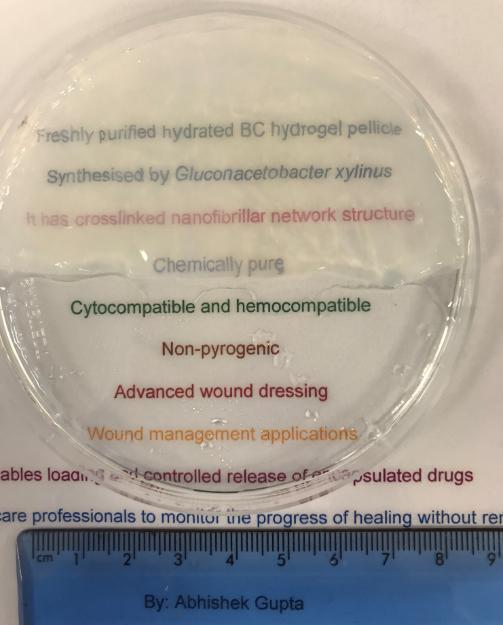The development of biosynthetic hydrogels with healing properties

Dr Abhishek Gupta, from the School of Allied Health and Midwifery, in the Faculty of Education, Health and Wellbeing (FEHW) blogs about how he’s been actively working to tackle the management of non-healing chronic wounds.
You may wonder how wounds occur, how some can repair by themselves, some need medical assistance and others do not heal at all.
The skin forms an external covering of the body and serves several functions including its protective function as a physical barrier against infectious microbes. When the anatomical structure of the skin is disrupted due to injury or trauma, no matter surgical incision or accidental, its physiology is compromised due to loss of its integrity, and this is classified as a wound.
The body has the potential of repairing wounds but in some situations, an underlying health condition and/or nutritional deficiencies, this capability may get hampered.
Wound healing is a complex cascade of cellular and biochemical processes, when proceeds uninterrupted, leads to wound healing. Contrary to this, when wounds get halted during the healing process, this can lead to non-healing wounds. These wounds are hard to heal, and their management is complicated leading to an immense socioeconomic burden.
One of the major factors where the body fails to progress through healing stages is uncontrolled infections. This factor alone may lead to other conditions at the wound site that oppose the body’s healing capability. This problem is further amplified due to the emergence of microbes that are non-responsive to existing antibiotics which limits the ability of clinicians to treat these wounds.
Over the last five years or so, I have been working to produce a biosynthetic cellulose-based material - capable of maintaining a moist climate at the wound bed, which has been proven to facilitate healing.
The dressing
This material is biosynthesised by bacteria, called bacterial cellulose which is then harvested. After purification, it gets ultra-pure and demonstrates desirable properties including good mechanical strength, cytocompatibility and hemocompatibility. These bacterial cellulose pellicles are over 95 per cent water which imparts soft and malleable features suitable for its potential application as a hydrogel wound dressing. In addition to its inherent moist nature, it has a unique 3D interwoven network structure and a property of swelling and deswelling which enabled us to load it with healing agents.
Healing agents
Considering multiple drug resistance to antibiotics, I worked with Professor Radecka and chose silver zeolites as a natural antimicrobial agent. Silver zeolites were loaded in bacterial cellulose matrices to produce silver zeolite-loaded bacterial cellulose and these hydrogels demonstrated antimicrobial properties against common pathogens, Staphylococcus aureus and Pseudomonas aeruginosa.
Chronic non-healing wounds, in addition to high microbial bioburden, usually have prolonged inflammation and high oxidative stress. In order to tackle these multiple factors, I extended this research project by choosing a different natural healing agent, curcumin – which is an active compound of turmeric, and as well as being a well-loved spice, also has many health benefits and is packed with antimicrobial, anti-inflammatory and antioxidant properties.
Outcome
Curcumin-loaded bacterial cellulose hydrogels demonstrated promising healing properties including anti-staphylococcal activity and antioxidant properties. Based on in vitro test results, these hydrogels may allow monitoring of the healing process without the need for the removal of dressings, which is an extra feather in its hat.
Amalgamating the benefits of silver and curcumin, I developed a novel technique to produce silver nanoparticles, following the green chemistry approach. These nanoparticles were loaded in bacterial cellulose to produce hydrogels.
Dr Abhishek Gupta has presented his research findings in several national and international conferences and succeeded in having his work published in peer-reviewed journal articles. He has developed national and international collaborations with an aim of taking this project to the next level and is open for further collaborations with research-active groups.
Dr Abhishek Gupta is keen to develop industrial collaborations to translate these hydrogels into proprietary wound dressing that becomes available for patients to benefit the lives of people living with chronic wounds.
To find out more about Abhishek’s work click here.
Image one: BC after Purification
Image two: Normal saline-loaded BC
Image three: Demonstration of transparency through curcumin-loaded BC
Image four: Demonstration of transparency through curcumin reduced silver nanoparticle-loaded BC



For more information please contact the Corporate Communications Team.


/prod01/wlvacuk/media/departments/digital-content-and-communications/images-18-19/iStock-163641275.jpg)
/prod01/wlvacuk/media/departments/digital-content-and-communications/images-2024/250630-SciFest-1-group-photo-resized-800x450.png)
/prod01/wlvacuk/media/departments/digital-content-and-communications/images-18-19/210818-Iza-and-Mattia-Resized.jpg)
/prod01/wlvacuk/media/departments/digital-content-and-communications/images/Maria-Serria-(teaser-image).jpg)
/prod01/wlvacuk/media/departments/digital-content-and-communications/images-2024/241014-Cyber4ME-Project-Resized.jpg)
/prod01/wlvacuk/media/departments/digital-content-and-communications/images-18-19/210705-bric_LAND_ATTIC_v2_resized.jpg)
